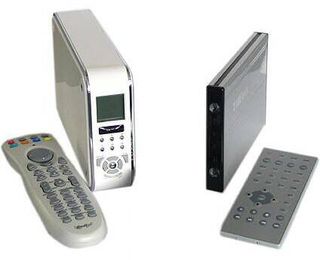Hard Disk Drive Video Players Hit The Mainstream
Introduction

External storage with DivX, XVid and DVD output
DVD players can be found in almost every living room today, having long ago replaced VHS VCRs. Many of these players can even play back files encoded in DivX and MP3. But there's a big catch to using these formats, too: you have to squeeze the files onto a blank DVD so that you can stick them in the standalone player. And that in turn means that you have to have your own DVD burner and lots of blank DVDs.
One new alternative is the use of hard disk drive (HDD) players that are based on a 2.5" or 3.5" IDE (ATA) hard drive. These video players dispense completely with optical media; the files are transferred via USB 2.0 to the installed hard drive and played from it directly. The copy process takes about a minute per gigabyte; the files are then played back directly from the disk of the HDD player with the same ease as using DVD players, and of course, with the convenience of a remote control.
HDD players support a wide range of video and audio compression methods. Among the best-known are DivX, xVid and MP3. Unlike MPEG-2 (DVD), DivX-coded files are considerably smaller and thus take up less room. Thanks to constantly improving video code compression algorithms, DivX and the others are more than a match for their DVD counterparts. The latest functions of the DivX codec now even support menus and chapter selection, similar to what we're used to with DVDs. Unfortunately these menus are (still) not supported by the players. Thus, if you want to continue to use this convenience, you will have to switch to the DVD structure. The video_TS directory familiar to us from the DVD medium is accepted by HDD players. All functions such as chapters, subtitles, alternative languages or camera angles can be used just as with a standalone DVD player. It is only a matter of time until the boxes support these DivX codex functions, probably via a firmware update.
Players will refuse to play protected MP3 files downloaded from the Internet, such as I-Tunes files. The same goes for video download portals that offer DVD or AVI files. Files protected with digital rights management (DRM) always need online access, which HDD players don't have. Only after you get a release code can the DRM file be played back, for example on Microsoft Media Player. This received code, however, only applies to that one computer and cannot be transferred to the HDD player or any other computer.
Our three test candidates have gigantic amounts of storage. With a 500 GB hard drive, you could store roughly 10,000 minutes of video in MPEG-2. With DivX-compressed video files, that would in theory mean 60,000 minutes or almost 1,000 hours of video! Sounds great, doesn't it? And you don't have to cut any corners on quality. In the case of MP3 music files, that storage would amount to a guaranteed 3 months of uninterrupted playback!
Stay on the Cutting Edge
Join the experts who read Tom's Hardware for the inside track on enthusiast PC tech news — and have for over 25 years. We'll send breaking news and in-depth reviews of CPUs, GPUs, AI, maker hardware and more straight to your inbox.
Most Popular


